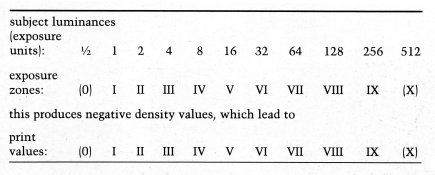Stephen Benskin
Member
I’ve always found it a bit strange that the Zone System is so vague when it comes to calibration. The argument that it’s because a Zone is a range doesn't cut it for me. Just because a Zone is a range doesn’t mean a range can’t be defined and the mid point of that range determined. Adams does offer a target negative density range, and based on that people have extrapolated approximate target densities for the individual Zones.
Paper is another matter. Adams is even more vague on paper calibration. He doesn’t even touch on log exposure ranges. This makes it more difficult to extrapolate the reflection densities for the various Zones.
What I’d like to do is to present a series of models without any judgment. There is a question, however, that I’d like to propose. People talk about placing a subject value on a particular Zone, yet does this have any real meaning if there isn’t a corresponding value on the print?
All of the examples use the same paper curve. The only difference is how the print Zones are distributed on the curve. These are only a few possible models. There are probably other sources with different values.
One approach to defining the paper Zones is to use equally spaced log exposures. As the paper has approximately twice the gradient as the negative. Each 0.30 subject luminance difference would translate into approximately 0.15 log exposure difference. The first example begins with Zone VIII at 0.04 over Pb+f and each subsequent Zone is at intervals of 0.15 log exposure.
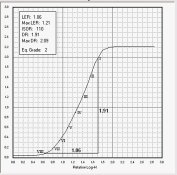
The second example uses the reflection densities as defined in Way Beyond Monochrome.
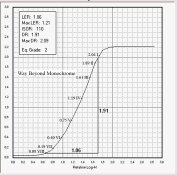
The third example uses the preferred reproduction densities in Jack Holm’s paper Exposure-Speed Relations and Tone Reproduction. His values are adjusted to include Pb+f.
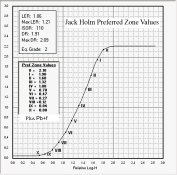
The fourth example shows the placement of the Munsell Values on the paper curve. These values are psychophysically determined to appear equal spaced.
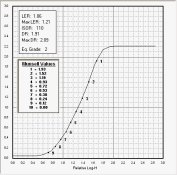
The fifth example is from the third quadrant in a tone reproduction diagram which has a subject luminance range of 2.10, slightly more than one stop flare, and a negative processed to a CI 0.58. This example isn't suggesting these are the only possible Zone placements under the stated conditions. A slight tweak in the printing exposure can easily lighten the mid-tone, placing Zone V at RD 0.74 without too much of a change in the the highlight and shadow values.
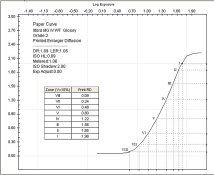
Paper is another matter. Adams is even more vague on paper calibration. He doesn’t even touch on log exposure ranges. This makes it more difficult to extrapolate the reflection densities for the various Zones.
What I’d like to do is to present a series of models without any judgment. There is a question, however, that I’d like to propose. People talk about placing a subject value on a particular Zone, yet does this have any real meaning if there isn’t a corresponding value on the print?
All of the examples use the same paper curve. The only difference is how the print Zones are distributed on the curve. These are only a few possible models. There are probably other sources with different values.
One approach to defining the paper Zones is to use equally spaced log exposures. As the paper has approximately twice the gradient as the negative. Each 0.30 subject luminance difference would translate into approximately 0.15 log exposure difference. The first example begins with Zone VIII at 0.04 over Pb+f and each subsequent Zone is at intervals of 0.15 log exposure.

The second example uses the reflection densities as defined in Way Beyond Monochrome.

The third example uses the preferred reproduction densities in Jack Holm’s paper Exposure-Speed Relations and Tone Reproduction. His values are adjusted to include Pb+f.

The fourth example shows the placement of the Munsell Values on the paper curve. These values are psychophysically determined to appear equal spaced.

The fifth example is from the third quadrant in a tone reproduction diagram which has a subject luminance range of 2.10, slightly more than one stop flare, and a negative processed to a CI 0.58. This example isn't suggesting these are the only possible Zone placements under the stated conditions. A slight tweak in the printing exposure can easily lighten the mid-tone, placing Zone V at RD 0.74 without too much of a change in the the highlight and shadow values.

Last edited by a moderator:





